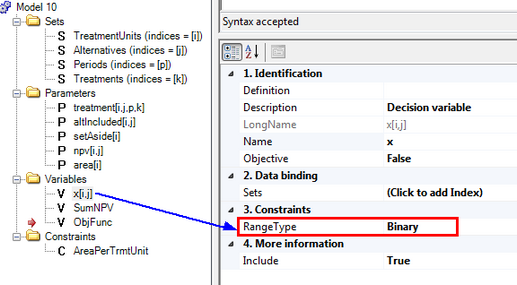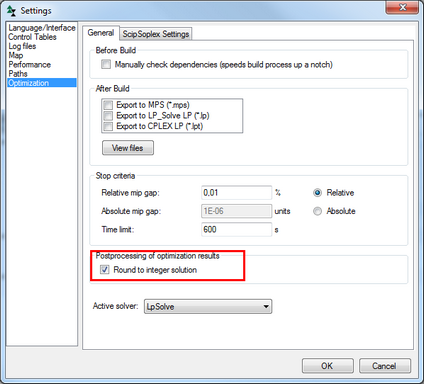About integer solutions
The model type is LP-problem (linear programming) with or without integer terms (MIP or MILP, Mixed-Integer LP). These two differ in how management programs are assigned. If a stand cannot be split, x-variables in the model can be set as binary. If a stand can be split, or if it should be split but it is not possible to solve a spatial problem, these variables can be considered as continuous variables with values from 0-1, indicating the proportion of a stand’s area that should be treated with a certain management program.

Figure 1. To set the x-variables as 0-1 integers, select RangeType = Binary (instead of Custom with bounds 0 and 1).
If you add integer or binary bounds to decision variables the model may become much more demanding to solve, and it could alos becom infeasible. The included free solver, LP_Solve, is far less efficient than commercial solvers like Gurobi, Cplex and Xpress. Execution times can be more than 100 times longer with LP_Solve, and LP_Solve will have more difficulties to find solutions to difficult problems.

Figure 2. If the x-variables are not binary in the optimization model, but you want to round them to 0 or after solving, check Round to integer solution in the Optimization settings.
As an alternative to solve a problem as an MIP-problem, the built-in rounding function can be activated, given that the optimization model is not truly combinatorial. This means that there should be no explicit dependency between two different decision variables in the model, except that their values affect a common constraint such as sum in a restriction. The rounding is very simple, so that for each stand the management program is selected that has been assigned the largest value in the LP solution.
The number of stands that obtain a fractional value in an LP solution (a value between 0 and 1 instead of 0 or 1) is never larger than the number of restrictions. Example: If a model has 20 restrictions, then at most 20 stands will get fractional values. Note that a restriction node in the model tree (in the optimization model builder) often involves iteration over one or several sets. For example, the expression "forall <p> in Periods ..." means that one constraint is created for each time period.
A rounded solution will violate at least one restriction if the model contains at least one binding restriction.
|
The difference between a truly integer solution (from an MIP-model) and a rounded solution will thus depend on the number of stands and the number of restrictions. A rounded solution will violate at least one constraint formulated in the model, given that the model has restrictions that affected the solution (a restriction may well be non-binding in a specific case, for example, a requirement that is always met). For example, an even-flow constraint may not be violated to a small or large degree. It is up to you as a user to check the results by using the report builder, and determine if violations are acceptable. Note that saved results may differ from the result shown in the Output window from solver, since the rounding is applied after the solver has finished.
Note that the saved results may differ from the result shown in the solver output if rounding is used.
|

